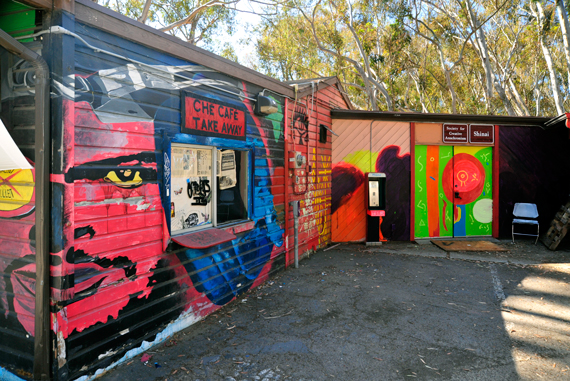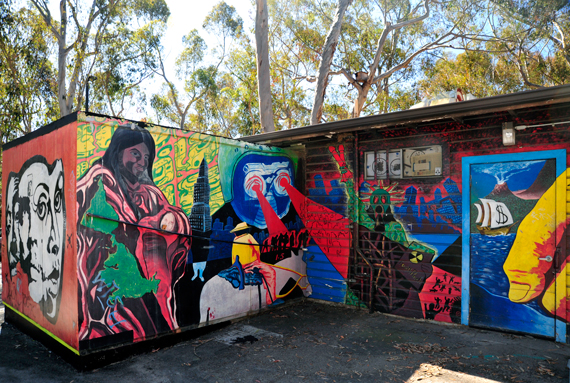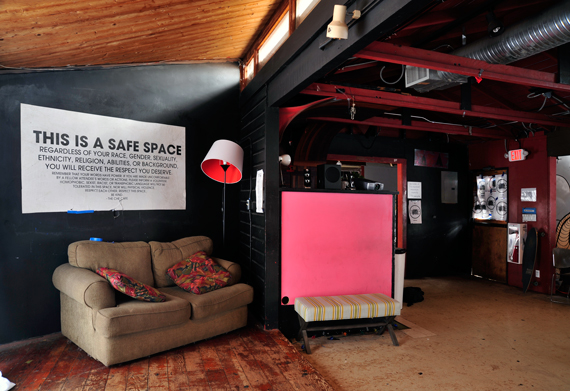|
Off SOHO's Most Endangered List, Che Cafe Celebrates its 50th
March/April 2017
By Jaye MacAskill



One of the last vestiges of the 1960s counter-culture movement at UCSD, Ché Café is celebrating its 50th anniversary this year. The modest but mighty Che was the university's first student center, a snack bar initially called The Coffee Hut, that was once the only place on campus where students and faculty could hang out after hours and on weekends.
A post-World War II example of adaptive reuse, the funky, rambling U-shaped building was constructed out of three wooden barracks relocated from the former Camp Matthews nearby. In 1970, San Diego Master Architect Paul McKim expanded and re-envisioned the site, connecting the barracks and giving the compound a more Modernist aesthetic. Although the Che is notably smaller than most of the buildings at UCSD, it is still one of the most recognizable: A colorful collection of murals covers its fortress-like exterior and conveys its distinctly revolutionary sense of identity.
A long-standing source of controversy for the UCSD administration, the Che has served as a bastion for free speech, social justice, progressive ideals, and non-traditional lifestyles since the turbulent late sixties. Countless meetings, concerts, poetry readings, plays, lectures, and other activities have attracted a faithful following. The Che has also played a leading role in San Diego's youth-oriented punk rock music scene for more than a quarter century.
Considered a safe space with a tradition of welcoming all people regardless of race, gender, or sexual orientation. It has been a quiet leader in the LGBTQ movement, adopting the concept of non-gender-assigned bathrooms early on, and hosting dances for gay and lesbian students since the 1970s.
In the 1980s, after years of tension between students and the administration, the snack bar was taken over by a student-run collective and renamed the "C.H.E. Cafe." Standing ostensibly for "Cheap Healthy Eats" in reference to the cafe's popular vegetarian and vegan menu, the name also doubles as a not-so-subtle nod to Latin American revolutionary leader Che Guevara. Guevara's image is immortalized on the Che's logo and on a mural inside the courtyard by San Diego Chicano artist Victor Ochoa.
The Wall of Human Rights Heroes, the massive mural on the Che's street-facing façades, was painted in the 1990s by Mario Torero, who, like Ochoa, is one of the leading artists of Chicano Park in Barrio Logan. A major statement, the wall features a large portrait of former UCSD student Angela Davis, who later became a leader in the African-American student rights and feminist movements. Davis's image is surrounded by portraits of other notable social justice crusaders, including Gandhi and Cesar Chavez.
When the Ché Café was placed on SOHO's Most Endangered List in 2015, the future of the building and its murals had been critically threatened by an eviction notice served by the UCSD administration to the collective. The situation became so dire that students occupied the space 24 hours a day, even during summer break, to make sure the university didn't seize the building and tear it down for "safety concerns."
Now, nearly two years later, negotiations are still underway. The administration appears to have gained a better appreciation of the Che's unique history plus a greater understanding of its important role as an intellectually infused alternative space for the campus community. The chancellor is finally showing a commitment to saving the Che by improving safety conditions while preserving its important historic features.
To celebrate the 50th Anniversary of the Coffee Hut, the Che's historical task force will offer monthly tours of the building, murals, and the surrounding eucalyptus grove with its many hidden features, like art installations and gardens. The next tour will be held Saturday, March 4, from 4 to 5pm, and every first Saturday of the month thereafter.
Future plans include mural restoration, interviews, a book, and possibly a historic register nomination. (The university's historic resources study has identified the site as historic.) SOHO supports students and others who argue that history, even history rooted in revolutionary ideas and discourse, deserves a place at the increasingly crowded UCSD table.
Do you have memories of visiting the Che to add to its social, cultural and political history? The task force is always looking for new volunteers to help with historical research and documentation, and welcomes personal stories about the Che from UCSD alumni, faculty, and community members. Volunteers are invited to a meeting every first Saturday of the month, including this Saturday, March 4, from 3 to 4pm. Please see the Ché Café Historical Tour page on Facebook for updates. (Search for Ché Café Historical Tour)
|
2025
2024
2023
2022
2021
2020
2019
2018
2017
2016
2015
|






